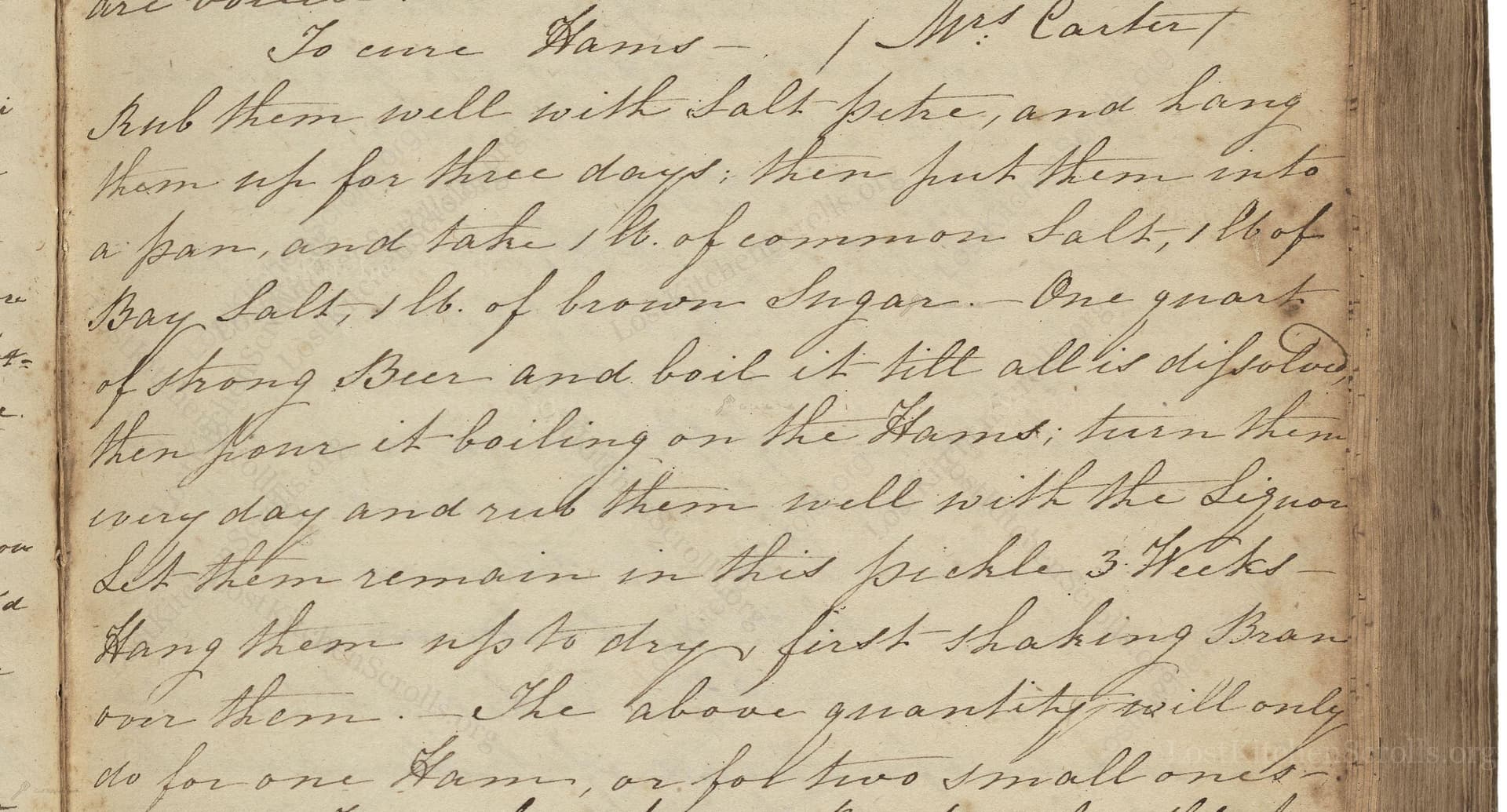To Cure Hams Mrs Carter
From the treasured pages of Receipt book of Jane Staveley
Written by Jane Staveley

To Cure Hams Mrs Carter
"rub them well with Salt Petre, and hang them up for three days: then put them into a pan, and take 1 lb. of common Salt, 1/2 lb of bay salt, 1/2 lb of brown sugar - One quart of strong Beer and boil it till all is dissolved, then pour it boiling on the Hams; turn them every day and rub them well with the liquor let them remain in this pickle 3 Weeks - Hang them up to dry, first shaking Bran over them. - The above quantity will only do for one Ham, or for two small ones."
Note on the Original Text
The recipe is written in a direct, functional style, typical of early modern English cookery manuscripts. Spelling and punctuation are irregular compared to today; 'Salt Petre' is now spelled 'saltpetre' or 'saltpeter,' and 'bay salt' can refer to a particularly coarse salt, sometimes flavoured with bay, but modern cooks may substitute with sea salt and bay leaves. Directions are concise and expect the reader to possess baseline kitchen knowledge—like knowing how and where to hang meat for curing, and the importance of cleanliness. Quantities are aligned with period weights but have been converted to metric for clarity.

Title
Receipt book of Jane Staveley (1693)
You can also click the book image above to peruse the original tome
Writer
Jane Staveley
Era
1693
Publisher
Unknown
Background
Step into the flavorful annals of the 17th century with Jane Staveley’s delightful culinary collection. Brimming with time-honored recipes and refined instructions, this book offers a sumptuous glimpse into the kitchens of yesteryear—where classic techniques met noble tastes and every dish was a celebration of ingenuity.
Kindly made available by
Folger Shakespeare Library
This recipe was recorded in the late 17th century (circa 1693–1694) by Jane Staveley, a period when home-curing meats was essential for preservation through the seasons. The use of saltpetre, salts, and sugar was standard not just for flavor, but to inhibit spoilage before refrigeration existed. During this time, recipes were often exchanged between households and attributed to prominent local women like 'Mrs Carter.' The addition of beer in the brine lends both flavor and some antiseptic qualities, a popular method in English country kitchens.

In the late 1600s, Mrs. Carter would have used sturdy wooden tubs or earthenware pans for salting and brining the ham. Heavy-duty meat hooks or ropes were used for hanging, usually in a cool dairy, larder, or smokehouse. Large iron pots or cauldrons heated over an open hearth would be employed to dissolve the brine ingredients. Wheat bran for dusting was kept in sacks, to be shaken over the hams with the hand. A sharp knife or cleaver for trimming, bare hands for all rubbing and turning; no gloves or modern kitchen gadgets in sight.
Prep Time
45 mins
Cook Time
0 mins
Servings
24
We've done our best to adapt this historical recipe for modern kitchens, but some details may still need refinement. We warmly welcome feedback from fellow cooks and culinary historians — your insights support the entire community!
Ingredients
- 1 whole ham (approx. 13–18 lb)
- 1 oz saltpetre (potassium nitrate; use with caution or omit for home curing regulations)
- 1 lb common salt
- 8 oz bay salt (or 8 oz coarse sea salt and 2-3 bay leaves as substitute)
- 8 oz brown sugar
- 1 quart strong beer
- 4 oz wheat bran (for dusting at the end)
Instructions
- To cure hams the old-fashioned way, start by rubbing your ham with 1 oz of saltpetre (potassium nitrate) all over, then hang it up in a cool, airy spot for 3 days.
- For the curing mix, combine 1 lb regular cooking salt, 8 oz bay salt (or substitute with 8 oz coarse sea salt plus a couple of bay leaves for aroma), and 8 oz brown sugar in a saucepan.
- Add 1 quart of strong beer, then heat until everything is dissolved into a brine.
- Pour this boilling mixture over your ham, making sure to coat it well.
- Every day, turn the ham and rubb it with the liquid again to ensure even curing.
- Keep the ham in this pickle for three weeks, staying diligent with your daily turning and rubbing.
- After three weeks, take the ham out, pat it dry, and dust it with wheat bran before hanging it up to dry thoroughly in a cool, dry, and breezy spot.
- This recipe is enough for one large ham or two smaller ones.
Estimated Calories
350 per serving
Cooking Estimates
You will spend around 45 minutes getting the ham and brine ready at the beginning. Most of the time is passive, letting the ham cure in the brine for three weeks and then dry out. No actual cooking time is needed.
As noted above, we have made our best effort to translate and adapt this historical recipe for modern kitchens, taking into account ingredients nowadays, cooking techniques, measurements, and so on. However, historical recipes often contain assumptions that require interpretation.
We'd love for anyone to help improve these adaptations. Community contributions are highly welcome. If you have suggestions, corrections, or cooking tips based on your experience with this recipe, please share them below.
Join the Discussion
Rate This Recipe
Dietary Preference
Main Ingredients
Occasions

Den Bockfisch In Einer Fleisch Suppen Zu Kochen
This recipe hails from a German manuscript cookbook compiled in 1696, a time whe...

Die Grieß Nudlen Zumachen
This recipe comes from a rather mysterious manuscript cookbook, penned anonymous...

Ein Boudain
This recipe comes from an anonymous German-language manuscript cookbook from 169...

Ein Gesaltzen Citroni
This recipe, dating from 1696, comes from an extensive anonymous German cookbook...
Browse our complete collection of time-honored recipes



